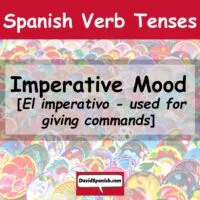La Bamba (Meaning: the beat) is a traditional Mexican folk song from the state of Veracruz. While the song lyrics were often traditionally improvised, the earliest recording was made by Alvaro Hernández Ortiz in 1938. In 1958, Ritchie Valens made the song famous with his rock version rising to the top of the US charts. In …
David Issokson
Bésame Mucho (Meaning Kiss me a lot or much; Pronunciation: Bay-sah-may moot-cho) is the most famous song written by Mexican singer Consuelo Velázquez and arguably one of the most famous Spanish langauge songs of all time. This post explains the vocabulary and grammer of the song’s Spanish lyrics, which are actually not very difficult to …
Querida (Meaning: Dear; Pronunciation: ker-ee-dah) is the single most popular song by Juan Gabriel, one of Mexico’s most famous singers of all time. Querida appeared on the album Recuerdos, Vol. II, which was released in 1984 and was Mexico’s best selling album in history with over seven million sales.
In Spanish, verbs are called reflexive when a subject both carries out and receives an action. These verbs equate to the -self and -selves verbs in English. Reflexive verbs in Spanish are often used for daily routines.
Cielito Lindo (Meaning: Pretty little sweetheart; Pronunciation see-ehl-ee-toh leen-doh) is a famous Mexican folk song made famous by author Quirino Mendoza y Cortés in 1882. In this post we’ll provide a line-by-line explanation of the song lyrics vocabulary, verbs and grammar.
In Spanish, the imperative mood (imperativo) is used for giving commands. The imperative is always conjugated in the present tense and omits the personal pronoun. The imperative exists in five main forms: (tú) ¡habla! (speak!), (used) ¡hable! (speak!), (nosotros) ¡hablemos! (vosotros) ¡hablad! and (ustedes) ¡hablen! This post will explain precisely how to conjugate and use …
What is the Spanish conditional tense? The Spanish conditional tense is used to express hypothetical actions and equates to “would” in English. For regular AR, ER, and IR verbs, it is formed by adding the following endings to the infinitive: -ía, -ías, -ía, -íamos, -íais, -ían. In this post you’ll learn how to form and …
What is the Spanish future tense? In Spanish, the future tense is formed by adding the following endings to the infinitive form of the verb: -é, -ás, -á, -emos, -éis and -án. The future tense equates to “will” in English. For example, yo hablaré (I will speak). Another future tense called the “near future tense” …
What is the progressive present tense in Spanish? In Spanish, the present progressive tense equates to is + verb + -ing in English. It is used to express an action that is in progress and not completed. For example, yo estoy hablando (I am speaking). The present progressive tense in Spanish is formed by combining …
How to use conjugate and use the imperfect tense in Spanish The imperfect tense used to describe states of being and habitual actions in the past. It is used to express past continuous actions with unknown start and completion times. Equivalents for the imperfect in English are “used to do” and “was doing”. The imperfect …










